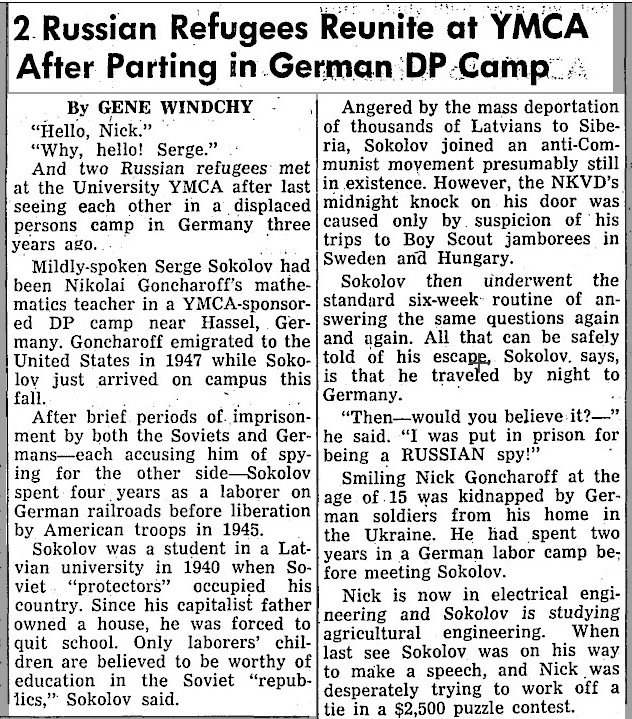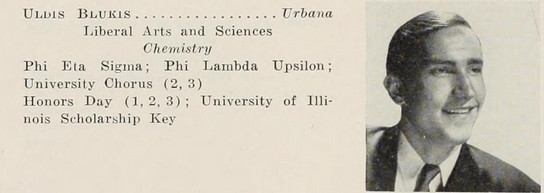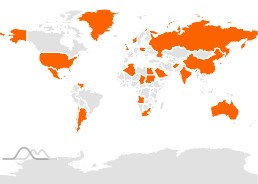Since at least 1920, Latvian students have been attending the University of Illinois. They have included agricultural engineers, authors, chemists, dancers, dentists, diplomats, educators, musicians, military officers, philosophers, and volleyball players. While they have been a smaller student population, Latvian students have been big participants in multicultural activities and events on campus. Read on to learn about early Latvian Illini!
Dr. Sara Gdulin Krout
The first Latvian student may be College of Dentistry graduate Dr. Sara Gdulin Krout, (DDS 1924). Prior to graduation, Dr. Krout completed a Doctorate of Dental Surgery at the University of Riga, making her University of Illinois DDS her second doctorate. After graduation, Dr. Krout ran a private dental practice until she joined the Women Accepted for Voluntary Emergency Service (WAVES) of the United States Naval Reserves in 1943. In fact, Dr. Krout was the first female dentist in the United States Armed Forces and she retired in 1961 as a commander. Dr. Krout was active in dental societies, the Association of Military Surgeons, a staff member of the Women and Children’s Hospital of Chicago, a member of the women’s executive committee of the Office of the Superintendent of Public Instruction of the State of Illinois, and a member of the Asthmatic Children’s Aid Society. [1]
World War Two Displaced Persons
As a result of World War Two fighting and post war governmental changes, among other nations, many Latvians were displaced from their homes and they were unable to return to Latvia. Some Latvians came to the United States and some came to the University of Illinois for education.
Sergej Alexander Sokolov
Sergej Alexander Sokolov of Riga, (B.S. Agricultural Engineering, 1953) had a long journey before arriving at the University. In an interview with the DI, Mr. Sokolov described a series of familial and personal challenges experienced under the Soviet Latvian Government. While he was a University of Riga student, Mr. Sokolov watched his country change and he eventually left. First, Mr. Sokolov’s father’s home was confiscated by the new government. Then, angered by the mass deportations of thousands of Latvians to Siberian labor camps, Mr. Sokolov joined an anti-communist movement. Some time later, during the late night, there was a knock on his door and Mr. Sokolov was questioned by Soviet Union law agency officers (NKVD) regarding his participation in Boy Scout jamborees in Hungary and Sweden. After six weeks of repeated questioning, Mr. Sokolov left Latvia for Germany where German authorities accused him of being a Soviet spy. Mr. Sokolov spent time in a German prison before being transferred to the German railroads where he labored for years. After World War Two ended, Mr. Sokolov was transferred to a displaced persons camp where he worked as a mathematics tutor, until he was eligible to leave for the United States. Finally, in the fall of 1950, Mr. Sokolov enrolled in the University. [2]
During the Cold War, displaced persons on campus were given opportunities to speak with the University community about their experiences. Indeed, on at least one occasion, Mr. Sokolov gave his own talk about Latvia to University audiences, through the YMCA’s United Nations Week radio program. [3] Otherwise, Mr. Sokolov was known as a soft-spoken man who was involved in the student chapter of the American Society of Agricultural and Biological Engineers, the YMCA, and the Daily Illini. [4] [5] [6]
Dr. Nikodems Bojārs
Nikodems Elijs Bojārs (B.S. Chemistry 1951, M.S. 1952, PhD, 1955) began his education in Latvia, continued his higher studies in Germany, and eventually completed his bachelors, Masters, and PhD at the University of Illinois. Dr. Bojārs arrived in 1949, along with nine other displaced students, supported by the off-campus Newman Foundation‘s Committee for Displaced Persons. [7] Dr. Bojārs was active in Newman Foundation leadership and events too. [8]
Dr. Bojārs’s research included work with NASA, the IIT Research Institute of Chicago, and the Hooker Chemical Corporation’s Research Center at Niagara Falls, New York. Dr. Bojārs was also an author and novelist writing as “Nick Bojars”. [9]
Dr. Uldis Bluķis
Uldis Bluķis, (B.S. Chemistry, 1956) was a co-salutorian for the February 1956 graduating class but his hard work began much earlier than his arrival in town in 1952. Before coming to United States, the Bluķis family lived in Latvia, where Mr. Bluķis’s father was a chemistry teacher and a director of an agricultural school. It was during Mr. Bluķis’s childhood, when he and his family left Latvia for Germany. From Germany, they came to the United States where his father found employment in Seattle, Washington. Later, Mr. Bluķis attended high school in Illinois, first in Oldenburg and later in Ridgefarm, before relocating to Urbana for his further studies. While he was a student, Mr. Bluķis worked in the University print shop and in the agronomy laboratory too. [10]
After graduation, Mr. Bluķis completed a PhD at the University of California at Berkeley, before becoming a Professor of Chemistry at Brooklyn College, CUNY. In the 1970s, in addition to other published research, Professor Bluķis co-authored a physical chemistry textbook too. During the 1990s, he served in the diplomatic service of Latvia and as a representative to the United Nations. [11]
Student Organizations
Since at least 1964, Latvian students have formed at least two different student organizations at the University of Illinois at Urbana-Champaign campus. Prior to the formation of the first Latvian student group, Latvian students performed dances and music at multicultural events on campus, when not excelling in athletic competitions too. In 1957, at the Illini Union’s annual “Big Show” international cultures showcase event, Latvian and Lithuanian students performed group dances. [12] Among those same Latvian students were fall intramural, volleyball champions in 1956 but could not follow their mid-season success in 1957 or in 1958. [13]
Daugava (1965-67)
From 1965 to 1967, Daugava was organized for “the study of Latvian culture and language”, and “the perpetuation of Latvian customs”, with graduate student Mrs. Ieva Ogriņš Hartwell (PhD Chemistry, 1969) as the advisor. [14] There are no records of student activities yet; however, future donations are always possible. All that is known is that the group began with ten Latvian members in 1965, before disbanding due to low enrollment in 1967.
Latvian Student Association (1972-74)
From 1972 to 1974, the Latvian Student Association was organized to “represent the interests of Latvian students on campus”. [15] There are no records of student activities yet; however, future donations are always possible. All that is known is that the group began with five Latvian members in 1972 before disbanding in 1974.
Greater Latvian student enrollment continued through the 1970s; however, enrollment from Latvians abroad has decreased. Since, at least the 1970s, many future Latvian students have been born outside of Latvia. While peak enrollment of Latvian students may have been after World War Two, Latvian students near and far continue to come to the University today.
Are you a Latvian Illini? Do you know someone who is? We’d like to hear from you! Please send us a message or leave a comment below. We want to include you and your story, as we celebrate the first 150 years of the University of Illinois.
Happy First 150 everyone!
(A special thank you to the 2015-2016 University of Illinois Slavic Graduate Student Association and Dr. David Cooper who gave feedback on an early version of this work.)
References
[1] “First Woman Dentist Retires“, United States Navy Medical News Letter, Volume 39, Number 5, March 2, 1962, page 25. For two additional photos, courtesy of Cliff Tabin, please see the online Sindecuse Museum of Dentistry exhibit “Women Dentists: Changing the Face of Dentistry“.
[2] This article includes an interview with another displaced person and Illini, Nick Goncharoff of Ukraine. A photo of both men is included. “2 Russian Refugees Reunite at YMCA After Parting in German DP Camp”, The Daily Illini, October 11, 1950, page 6.
[3] “Latvian to Speak on UN Program”, The Daily Illini, October 25, 1951, page 2.
[4] Please see the 1951, 1952, and 1953 Illios for photographs. Illio, Record Series 41/8/805.
[5] “YM Nominates Daugherty, Lauchner for President; Elections Friday”, The Daily Illini, March 14, 1951, page 2; “Foreign Students to Relate Work of YMCA”, The Daily Illini, April 19, 1952, page 5.
[6] Only one issue of the Daily Illini lists an “Al Sokolov” as a Night Assistant Editor. Please see: The Daily Illini, May 19, 1953, page 6.
[7] The other nine displaced students were from Czechoslovakia, Hungary, “Polish Yugoslavia”, Ukraine, and Yugoslavia. “Miss Hlywa Introduced to WGS; Other DP Arrival Uncertain”, The Daily Illini, October 12, 1949, page 1.
[8] Please see: “Foundation Notes”, The Daily Illini, January 6, 1951, page 2; “Crusade Visit Set for C-U”, The Daily Illini, September 28, 1951, page 1.
[9] A brief biography can be found on the Daugavpils, Latvia tourism center webpage. Please see: “Nikodems Bojars“, Daugavpils Tourist Information Centre.
[10] “4 Top Grads Announced”, The Daily Illini, January 18, 1956, page 1.
[11] “Edgars Rinkēvičs presents the Foreign Ministry’s Certificate of Commendation to Uldis Bluķis“, Ministry of Foreign Affairs of the Republic of Latvia, May 27, 2015.
[12] “15 Countries in ‘Big Show'”, by Mary Seibert, The Daily Illini, December 5, 1957, page 2.
[13] “Intramural Minor Events Highlight Break Between Seasonal Sports”, by Chuck Bills, The Daily Illini, December 11, 1957, page 11; “Evans Take IM Indee Title”, The Daily Illini, May 28, 1958, page 11.
[14] “Daugava”, Record Series 41/2/41, Box 8.
[15] “Latvian Student Association”, Record Series 41/2/41, Box 15.







